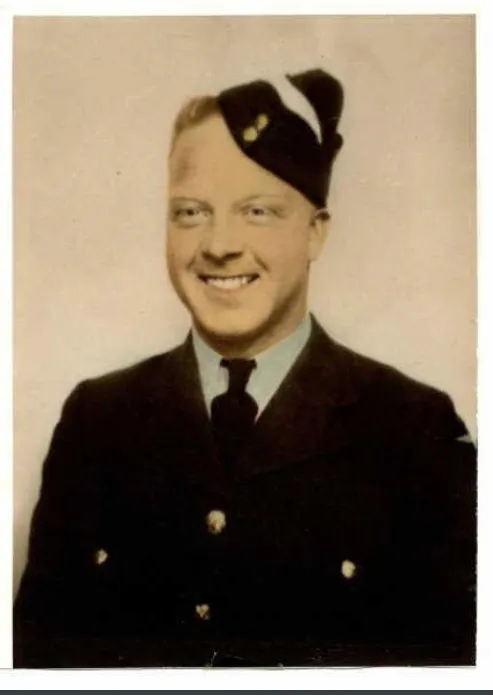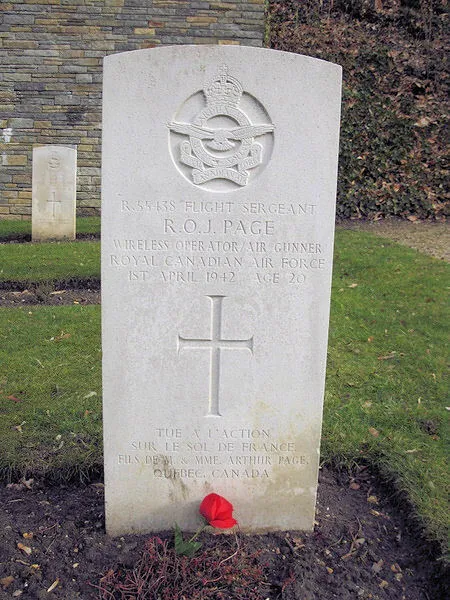Burgoyne, Laurel Glenwood (Flight Lieutenant)
Prisoner of War 1942-April-01


Birth Date: unkown date
Born:
Parents:
Spouse:
Home: Mahone Bay, Nova Scotia
Enlistment:
Enlistment Date: unkown date
Service
RCAF
Unit
405 (B) Sqn- Squadron
Ducimus We Lead
Base
RAF Pocklington
Rank
Flight Lieutenant
Position
Observer
Service Numbers
J/15060
PoW: 111
Crew or Other Personnel
Wellington Z8527
Mission
Wellington Mk. II Z8527
Bombing Poissy, France 1942-April-01 to 1942-April-01
405 (B) Sqn (RCAF) Pocklington
Wellington Z8527, 405 Squadron RCAF; aircraft shot down and crashed near Versailles, France, during an operational flight over Poissy, France. Pilot Officer L G Burgoyne (RCAF): prisoner of war; Flight Sergeant M A G Howsan (RAAF), Sergeant M C Howe (RCAF), Flight Sergeant R O J Page (RCAF), Sergeant W P Ashun, Pilot Officer J G MacKinnon: killed;
On November 11, 1994, Remembrance Day in France, which is a public holiday, the Mayor and citizens of Manly in the presence of a delegation from its British "twin town", Marlow-on-Thames, commemorated the crash of the Canadian Wellington with a moving ceremony on the military cemetery near Manly. A monument to the men who died was built by the Town and unveiled jointly by the Assistant Air Attachs, of Australia, Squadron Leader Lefevre, of Britain, Squadron Leader Whitaker and of Canada, Major Poisson, representing the nationalities of the dead airmen. The ceremony was witnessed by a delegation from Marlow, led by the Mayor with, amongst others, representatives from the Royal British Legion and the Aircrew Association. All the organizations present laid wreaths. Our French friends, especially the ex-Service organizations who had been witnesses to the efforts and sacrifices made during the war, by amongst others, the allied air forces, were overwhelming in their demonstrations of friendship and comradeship. Detail provided by David E. Thompson, Middlesborough, England.
Wellington serial: Z8527

Vickers Wellington B. Mk. III (Serial No. X3763), coded KW-E, No. 425 'Alouette' (B) Squadron, RCAF, late summer of 1942
The Vickers Wellington was a British twin-engined, long-range medium bomber. It was designed during the mid-1930s at Brooklands in Weybridge, Surrey. Led by Vickers-Armstrongs' chief designer Rex Pierson, a key feature of the aircraft is its geodetic airframe fuselage structure, which was principally designed by Barnes Wallis. Development had been started in response to Air Ministry Specification B.9/32, issued in the middle of 1932, for a bomber for the Royal Air Force. This specification called for a twin-engined day bomber capable of delivering higher performance than any previous design.
The Wellington was used as a night bomber in the early years of the Second World War, performing as one of the principal bombers used by Bomber Command. During 1943, it started to be superseded as a bomber by the larger four-engined "heavies" such as the Avro Lancaster. The Wellington continued to serve throughout the war in other duties, particularly as an anti-submarine aircraft.
It holds the distinction of having been the only British bomber that was produced for the duration of the war, and of having been produced in a greater quantity than any other British-built bomber. The Wellington remained as first-line equipment when the war ended, although it had been increasingly relegated to secondary roles. The Wellington was one of two bombers named after Arthur Wellesley, 1st Duke of Wellington, the other being the Vickers Wellesley.
In August 1936, an initial order for 180 Wellington Mk I aircraft, powered by a pair of 1,050 hp (780 kW) Bristol Pegasus radial engines, was received by Vickers; it had been placed so rapidly that the order occurred prior to the first meeting intended to decide the details of the production aircraft. In October 1937, another order for a further 100 Wellington Mk Is, produced by the Gloster Aircraft Company, was issued; it was followed by an order for 100 Wellington Mk II aircraft with Rolls-Royce Merlin X V12 engines. Yet another order was placed for 64 Wellingtons produced by Armstrong Whitworth Aircraft. With this flurry of order and production having been assured by the end of 1937, Vickers set about simplifying the manufacturing process of the aircraft and announced a target of building one Wellington per day.
A total of 180 Wellington Mk I aircraft were built; 150 for the RAF and 30 for the Royal New Zealand Air Force (RNZAF) (which were transferred to the RAF on the outbreak of war and used by 75 Squadron). In October 1938, the Mk I entered service with 9 Squadron. The Wellington was initially outnumbered by the Handley Page Hampden (also ordered by the Ministry to B.9/32) and the Armstrong Whitworth Whitley (to B.34/3 for a 'night' bomber) but outlasted both rival aircraft in service. The Wellington went on to be built in 16 separate variants, in addition to two training conversions after the war. The number of Wellingtons built totalled 11,462 of all versions, a greater quantity produced than any other British bomber. On 13 October 1945, the last Wellington to be produced rolled out. Wikipedia
Unit Desciption
405 (B) Sqn Ducimus ("Vancouver")
History of the Squadron during World War II (Aircraft: Wellington II, Halifax II, Lancaster I, III & X)
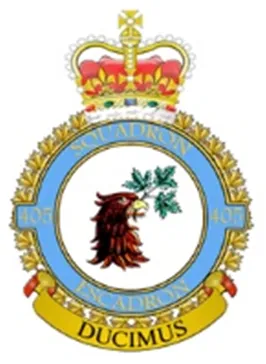
This was the first RCAF bomber squadron to be activated at Driffield, Yorkshire, England  and flew its first mission on 12/13 June 1941. At that time it was a member of 4 Group of Bomber Command, and flew successively from Driffield, Pocklington and Topcliffe, Yorkshire, England. With Code Letters LQ It flew Wellington Mk II aircraft until converting to Halifax II in April 1942, in time for the first 1000-bomber raid on Cologne. In October 1942 it was transferred to Coastal Command No 18 Group, flying over the Bay of Biscay from Beaulieu, Hampshire. Returning to Bomber Command, the squadron joined No 6 (RCAF) Group and flew from Topcliffe and Leeming, Yorkshire in March and April 1943. It was then seconded to No. 8 (Pathfinder) Group and for the rest of the war flew from Grandsen Lodge, Bedfordshire, UK
and flew its first mission on 12/13 June 1941. At that time it was a member of 4 Group of Bomber Command, and flew successively from Driffield, Pocklington and Topcliffe, Yorkshire, England. With Code Letters LQ It flew Wellington Mk II aircraft until converting to Halifax II in April 1942, in time for the first 1000-bomber raid on Cologne. In October 1942 it was transferred to Coastal Command No 18 Group, flying over the Bay of Biscay from Beaulieu, Hampshire. Returning to Bomber Command, the squadron joined No 6 (RCAF) Group and flew from Topcliffe and Leeming, Yorkshire in March and April 1943. It was then seconded to No. 8 (Pathfinder) Group and for the rest of the war flew from Grandsen Lodge, Bedfordshire, UK  . Its first Pathfinder mission was on 26th April 1943, and its last on 25th April 1945. It was slated to become part of the "Tiger Force" to attack Japan, but the surrender of Japan precluded that, and the Squadron was disbanded at Greenwood, Nova Scotia
. Its first Pathfinder mission was on 26th April 1943, and its last on 25th April 1945. It was slated to become part of the "Tiger Force" to attack Japan, but the surrender of Japan precluded that, and the Squadron was disbanded at Greenwood, Nova Scotia  on September 5th, 1945. One of the aircraft that flew briefly with the squadron was the first Canadian-built Lancaster Mk. X, KB700, christened the "Ruhr Express", which was subsequently transferred to 419 Sqn RCAF in December 1943.
Overall, the squadron flew 4427 sorties, of which 349 were with Coastal Command and 41 were in Operation Exodus, the repatriation of POWs. Nearly 25000 operational hours were logged together with 12,000 non-operational, and 12,856 tons of bombs were dropped. In the course of operations, 167 aircraft were lost with 937 aircrew. In the course of its history, squadron members were awarded 9 DSO's, 161 DFC's and 24 Bars to DFC's, 38 DFM's, 2 CGM's 2 BEM's and 11 MiD's. Battle Honours were: Fortress Europe 1941-44, France and Germany 1944-45, Biscay Ports 1941-45, Ruhr 1941-45, Berlin 1941; 1943-44, German Ports 1941-45, Normandy 1944, Walcheren, Rhine; Biscay 1942-43.Moyes, Kostenuk and Griffin
on September 5th, 1945. One of the aircraft that flew briefly with the squadron was the first Canadian-built Lancaster Mk. X, KB700, christened the "Ruhr Express", which was subsequently transferred to 419 Sqn RCAF in December 1943.
Overall, the squadron flew 4427 sorties, of which 349 were with Coastal Command and 41 were in Operation Exodus, the repatriation of POWs. Nearly 25000 operational hours were logged together with 12,000 non-operational, and 12,856 tons of bombs were dropped. In the course of operations, 167 aircraft were lost with 937 aircrew. In the course of its history, squadron members were awarded 9 DSO's, 161 DFC's and 24 Bars to DFC's, 38 DFM's, 2 CGM's 2 BEM's and 11 MiD's. Battle Honours were: Fortress Europe 1941-44, France and Germany 1944-45, Biscay Ports 1941-45, Ruhr 1941-45, Berlin 1941; 1943-44, German Ports 1941-45, Normandy 1944, Walcheren, Rhine; Biscay 1942-43.Moyes, Kostenuk and Griffin
Squadron History (Bomber Command Museum PDF)
Maps for Movements of 405 Squadron 1941-45
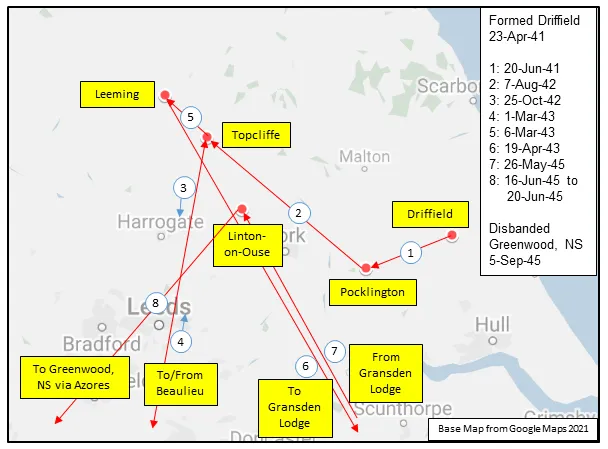
MAP 1: 405 Squadron Movements in Yorkshire 1941-45 (right-click on image to display enlarged in new tab)
|

MAP 2: 405 Squadron Movements in England 1941-45
|
405 Sqn History Summary 1941-45
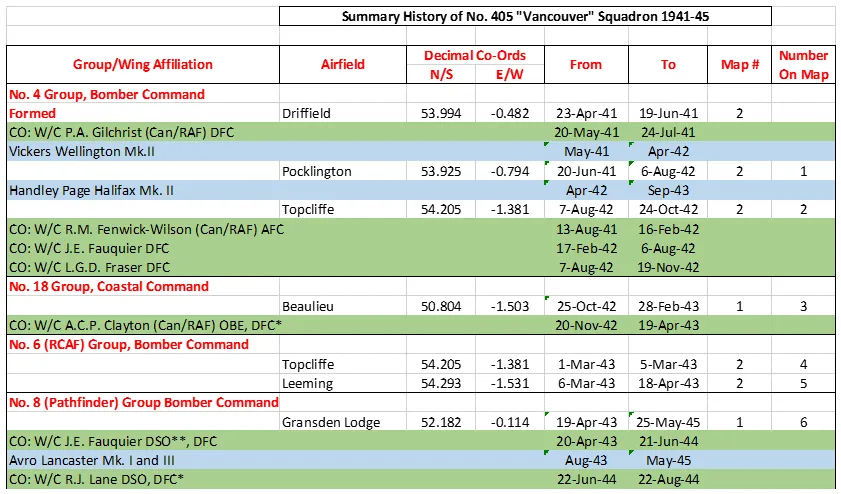
405 Sqn History Summary 1941-45 Page 2

History of the Squadron Post-WWII (Aircraft: Lancaster X, Neptune, Argus I & II, Aurora)
The squadron was re-formed as No 405 (Maritime Reconnaissance) Squadron at Greenwood, Nova Scotia  on 31 March 1950, and redesignated No 405 (Maritime Patrol) Sqn on 17 July 1956. The squadron was the first of four formed in Maritime Air Command. It flew modified Lancaster Mk. X aircraft until mid-1955, when they were replaced by P2V7 Lockheed Neptunes, which gave an enhanced anti-submarine capability. and the first to fly Lancaster, Neptune and Argus aircraft on East Coast maritime duty. In April 1958 the squadron was given the distinction of being the first to fly the Canadian-built CP-107 Argus. The squadron made its last flight in the Argus on 10 November 1980 before introducing the CP-140 Aurora. On 1 February 1968 the squadron was integrated into the Canadian Armed Forces. It is now designated No 405 Long Range Patrol Squadron, flying from Greenwood, NS.
on 31 March 1950, and redesignated No 405 (Maritime Patrol) Sqn on 17 July 1956. The squadron was the first of four formed in Maritime Air Command. It flew modified Lancaster Mk. X aircraft until mid-1955, when they were replaced by P2V7 Lockheed Neptunes, which gave an enhanced anti-submarine capability. and the first to fly Lancaster, Neptune and Argus aircraft on East Coast maritime duty. In April 1958 the squadron was given the distinction of being the first to fly the Canadian-built CP-107 Argus. The squadron made its last flight in the Argus on 10 November 1980 before introducing the CP-140 Aurora. On 1 February 1968 the squadron was integrated into the Canadian Armed Forces. It is now designated No 405 Long Range Patrol Squadron, flying from Greenwood, NS.
The squadron’s primary combat functions are Anti-Submarine Warfare (ASW) and Anti-Surface (ASUW). The Squadron regularly trains for its roles by participating in a number of naval exercises at home and abroad. However, most of its time is taken up in a number of non-combat roles, including search and rescue and support to other government departments, including counter-drug operations with the Royal Canadian Mounted Police (RCMP) and fisheries patrols with the Department of Fisheries and Oceans. Year-round, the Squadron carries out sovereignty patrols covering the Canadian Arctic Archipelago and maritime areas of interest . During these patrols, 405 LRPS crews maintain a constant vigil for ships that discharge pollutants illegal at sea. Similarly, its crews verify that foreign and Canadian fishing vessels abide by their Canadian licensing agreements and report suspected violators to DFO patrol boats.
405 LRPS regularly deploys to a number of allied bases for an assortment of exercises and missions. Among its international training sites are US NAS Keflavik (Iceland), US NAS Sigonella (Sicily, Italy), US NAS Oceana (Virginia, USA), US NAS Jacksonville (Florida, USA), US NAS Roosevelt Roads (Puerto Rico), UK RAF Kinloss (Moray, Scotland),UK RAF Station St. Mawgan (Cornwall, England) and NL NAS Valkenburg (Netherlands).
